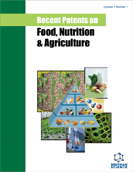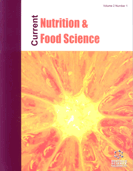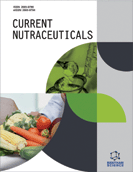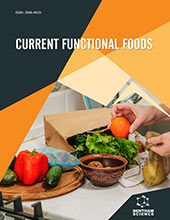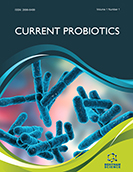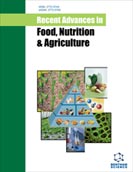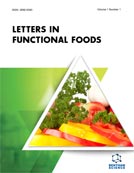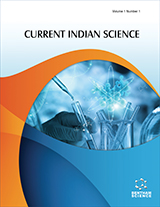Abstract
Prebiotics are food ingredients that promote host health beneficially due to their effect over the growth and activity of probiotic bacterial species. Prebiotic properties have been demonstrated for inulin-type fructans, galactoolicosaccharides and lactulose. Fructooligosaccharides (FOS), considered as inulin-type fructans, represent an important source of prebiotic compounds that are widely used as an ingredient in functional foods. FOS are produced by the action of fructosyltransferase from many plants, fungi and bacteria, and they are mainly composed of 1-kestose, nystose, and 1-β-fructofuranosyl nystose. Among them, 1-kestose has better therapeutic properties than those with a high polymeric degree (GFn > 4). FOS exhibited properties than those with a high polymeric degree (GFn > 4). FOS exhibited properties such as low caloric values, non-cariogenic properties, decrease levels of lipids and cholesterol, help gut absorption of ions, and stimulate the bifidobacteria growth in the human colon. This review presents a summary of the patents related with FOS production by industrial sucrose biotransformation or the use of recombinant fructosyltransferase enzymes. Also, a brief description of recent FOS applications will be discussed.
Keywords: Fructosyltransferase, fructooligosaccharides, prebiotics, functional foods
Recent Patents on Food, Nutrition & Agriculture
Title: Recent Trends in Fructooligosaccharides Production
Volume: 1 Issue: 3
Author(s): Felipe Guio, Mauro A. Rodriguez, Carlos J. Almeciga-Diaz and Oscar F. Sanchez
Affiliation:
Keywords: Fructosyltransferase, fructooligosaccharides, prebiotics, functional foods
Abstract: Prebiotics are food ingredients that promote host health beneficially due to their effect over the growth and activity of probiotic bacterial species. Prebiotic properties have been demonstrated for inulin-type fructans, galactoolicosaccharides and lactulose. Fructooligosaccharides (FOS), considered as inulin-type fructans, represent an important source of prebiotic compounds that are widely used as an ingredient in functional foods. FOS are produced by the action of fructosyltransferase from many plants, fungi and bacteria, and they are mainly composed of 1-kestose, nystose, and 1-β-fructofuranosyl nystose. Among them, 1-kestose has better therapeutic properties than those with a high polymeric degree (GFn > 4). FOS exhibited properties than those with a high polymeric degree (GFn > 4). FOS exhibited properties such as low caloric values, non-cariogenic properties, decrease levels of lipids and cholesterol, help gut absorption of ions, and stimulate the bifidobacteria growth in the human colon. This review presents a summary of the patents related with FOS production by industrial sucrose biotransformation or the use of recombinant fructosyltransferase enzymes. Also, a brief description of recent FOS applications will be discussed.
Export Options
About this article
Cite this article as:
Guio Felipe, Rodriguez A. Mauro, Almeciga-Diaz J. Carlos and Sanchez F. Oscar, Recent Trends in Fructooligosaccharides Production, Recent Patents on Food, Nutrition & Agriculture 2009; 1 (3) . https://dx.doi.org/10.2174/2212798410901030221
| DOI https://dx.doi.org/10.2174/2212798410901030221 |
Print ISSN 2212-7984 |
| Publisher Name Bentham Science Publisher |
Online ISSN 1876-1429 |
 38
38Related Articles
-
Effects of Oxymatrine from Ku Shen on Cancer Cells
Anti-Cancer Agents in Medicinal Chemistry Matrix Metalloproteinase Dependent Cleavage of Cell Adhesion Molecules in the Pathogenesis of CNS Dysfunction with HIV and Methamphetamine
Current HIV Research Mucoadhesive Polymers for Delivery of Drugs to the Oral Cavity
Recent Patents on Drug Delivery & Formulation The Role of Anionic Polysaccharides in the Preparation of Nanomedicines with Anticancer Applications
Current Pharmaceutical Design Targeting Tumor Ubiquitin-Proteasome Pathway with Polyphenols for Chemosensitization
Anti-Cancer Agents in Medicinal Chemistry Mir-320b Inhibits Pancreatic Cancer Cell Proliferation by Targeting FOXM1
Current Pharmaceutical Biotechnology Two-Dimensional (2D) In Silico Models for Absorption, Distribution, Metabolism, Excretion and Toxicity (ADME/T) in Drug Discovery
Current Topics in Medicinal Chemistry Phenolic Compounds: the Role of Redox Regulation in Neurodegenerative Disease and Cancer
Mini-Reviews in Medicinal Chemistry Drug release from ordered mesoporous silicas
Current Pharmaceutical Design Nanocarriers in Improved Heparin Delivery: Recent Updates
Current Pharmaceutical Design Specific Active Immunotherapy of Cancer: Potential and Perspectives
Reviews on Recent Clinical Trials Unusual Food Allergy: AlioideaAllergic Reactions Overview
Recent Patents on Inflammation & Allergy Drug Discovery A Rationale for the Use of Proton Pump Inhibitors as Antineoplastic Agents
Current Pharmaceutical Design Antioxidant Activity and Phenolic Contents of Ajwain, Mustard, Fenugreek and Poppy Seed
Recent Innovations in Chemical Engineering Diabetes Mellitus as a Risk Factor for Cancer: Stress or Viral Etiology?
Infectious Disorders - Drug Targets Inhibition of EGFR Signaling by N-cyclohexyl-2-(1-(phenylsulfonyl)piperidin-4-yl) acetamide
Anti-Cancer Agents in Medicinal Chemistry Effect of Liposomes with Different Double Arms Polyethyleneglycol on Hepatic Metastasis Model Mice and Evaluation Using a Fluorescent Imaging Device
Current Drug Delivery Targeted Strategies in the Treatment of Primary Gastric Lymphomas: From Rituximab to Recent Insights into Potential New Drugs
Current Medicinal Chemistry Synthesis of Medicinally Privileged Heterocycles through Dielectric Heating
Current Medicinal Chemistry The Biphasic Expression Pattern of miR-200a and E-cadherin in Epithelial Ovarian Cancer and its Correlation with Clinicopathological Features
Current Pharmaceutical Design


